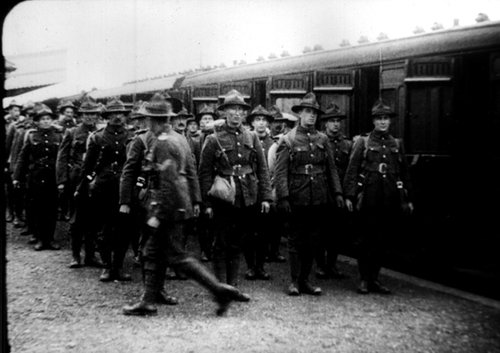
By Steve Russell
The man second from the left in the front row is Private Andrew Arthur Smith. An excerpt of the film that includes this image can be viewed on Ngā Taonga Sound & Vision’s website here.
On the 28th May 1917 Private Smith, along with his comrades in the 14th (Southland) Company of the 3rd Battalion Otago Regiment, marched out of Codford Military Camp on Salisbury Plain and boarded a train bound for the coast and a boat trip over the Channel. They were slated to join the New Zealand Division in the last stages of preparation for the battle at Messines. This was the penultimate leg on a journey that had taken Private Smith 10,000 miles around the globe, a world away from his parents’ farm at Bannockburn in Central Otago.
Smith fought at Passchendaele and in the battles of 1918 where he was wounded in action on 6 September 1918, seriously enough to require hospitalisation at Brockenhurst, one of the two base hospitals for New Zealand troops in England. He ended the war a sergeant, this last promotion in the field as a replacement for a fellow NCO, Sergeant Davis, killed in action on 13 April 1918. His younger brother Lawrence was killed in action on 25 August 1918 outside the village of Favreuil during the Division’s drive towards the town of Bapaume. Lawrence Smith had been in France for barely a month. He is buried in the small Commonwealth War Graves cemetery of L’Homme Mort in Northern France close to where he fell.
Following Andrew Smith’s demobilisation in 1919, he travelled to the Shetland Islands to visit his relations: both his parents were Shetlanders who had emigrated to New Zealand in the 1880s. While there he met a 24-year old island woman, Mary Moncrieff, with whom he formed an attachment. They corresponded regularly for several years and following his formal marriage proposal – by letter – Miss Moncrieff, along with her younger sister and brother, followed the path of many of their kinfolk and emigrated to New Zealand.
Andrew and Mary Smith had three children, all daughters: Lorna who died in infancy, Edna and the youngest Audrey, a petite redhead. The family farmed at Popotonua, in the foothills near Clinton, on land granted to Andrew Smith in the ballot for returned servicemen. Clinton’s memorial to the fallen of the Great War records the names of a dozen men from the area who did not return, the sons and brothers of their neighbours.
Andrew Smith died in 1966 less than a week from his 75th birthday. He lived to see both daughters married; Edna to Hugh McCall, himself a returned serviceman, this time from the Second World War, and Audrey to a young bank officer from Gore. He also saw all seven of his grandchildren born. Throughout his life he retained a close involvement with the local branch of his Returned Service Association, rarely missing an ANZAC Day Parade. A wedding photograph from 1923 shows him proudly displaying his RSA badge, the only decoration on his taut black suit.
In its essentials, this story will be familiar to many of the descendants of the over 100,000 New Zealand men and women who, between August 1914 and November 1918, went overseas to war.
For me its particularly familiar as Andrew Smith was my grandfather.
Hero image: New Zealand Boys in Sling Camp (1917). Private Andrew Arthur Smith is second from the left in the front row.